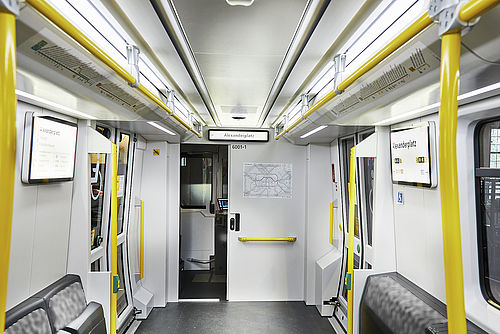From A to J
The Deutsches Technikmuseum presents in cooperation with the BVG (public transport company) and the vehicle manufacturer Stadler, until 7 August 2022 a mock-up of the brand new Berlin subway in the Rail Transport Exhibition located in the Engine Sheds. It is a 1:1 model of the new J/JK subway production series that the BVG ordered from Stadler in the spring of 2020.
Two historical Berlin subway cars are on display alongside the new arrival. Car 86 of the A1 series from 1908, the oldest surviving subway vehicle in Germany, is located right next to the mock-up on track 15. An F79 series twinset railcar from 1980, which is on display in the museum's outdoor area, rounds out the presentation.
Under the heading “From A to J – Berlin Underground Trains of Yesterday and Tomorrow”, the museum thus covers a span of 170 years, from the beginnings of the Berlin subway in 1902 to its future in 2072. The new trains are expected to be in service for more than 40 years. The subway production series are designated by consecutive letters whereby Berlin has now arrived at the letter “J”.
The new production series was specifically tested for accessibility by the Deutsches Technikmuseum. Various structural functions of the interior were tested and optimized as well.
SDTB / Foto: Malte Scherf
The F79 series twinset railcar from 1980, which is on display in the open-air area of the museum, has already gained "classic" status. The U7 line to Spandau (terminus Rohrdamm) was opened with exactly this vehicle on October 1, 1980.
SDTB / Foto: Malte Scherf
Displayed for the first time for museum visitors: subway car 86 of the A1 series from 1908, the oldest surviving subway vehicle in Germany.
SDTB / Foto: Malte Scherf
360-degree Model

SDTB / Foto: Malte Scherf
Fans of the Berlin subway can also virtually time-travel into the future. The trains of tomorrow are ready to be explored by means of a virtual walk-through 360-degree model, from the passenger compartment through the multifunction compartment and into the driver's cab. The whole K series vehicle can be traversed with the click of a mouse. Thanks to the high resolution, it is possible to zoom into every nook and cranny. Multimedia touchpoints utilize texts, audio or video clips to convey information on a variety of aspects such as passenger information, lighting design or user accessibility. The 360-degree model was created by TeamOn GmbH. It is based on approximately 200 individual images from a mock-up. More than 161 million pixels deliver a spectacular sharpness of detail.
